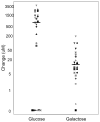Plasma concentrations of carbohydrates and sugar alcohols in term newborns after milk feeding
- PMID: 18391836
- PMCID: PMC2903005
- DOI: 10.1203/PDR.0b013e3181761888
Plasma concentrations of carbohydrates and sugar alcohols in term newborns after milk feeding
Abstract
Nonglucose carbohydrates such as galactose, mannose, and inositol play a clinically important role in fetal and neonatal nutrition, though little is known about their metabolism in the neonate. The aim of this study was to determine whether postprandial changes in plasma carbohydrate and sugar alcohol concentrations are affected by clinical variables such as postnatal age (PNA), milk type, feeding volume, or feeding duration in term newborns. Neonates (n = 26) taking intermittent enteral feedings were enrolled. Blood samples were obtained at baseline (immediately before the start of a feeding) and at 2-3 subsequent time points up to 110 min. Postprandial rise was only observed for plasma glucose concentrations [Glu] and plasma galactose concentrations [Gal] and clinical variables did not predict this change. Despite equimolar delivery in milk, the median of [Glu] rise minus [Gal] rise from baseline to second postprandial plasma sample was 674 microM (-38, 3333 microM; p < 0.0001), reflecting efficient hepatic first-pass metabolism of galactose. A significant PNA effect on [Gal] was observed such that for each day PNA there was an 18% decrease in [Gal] (p = 0.03). [Gal] are a function of PNA, suggesting maintenance of a significant ductus venosus shunt in term infants.
Figures


References
-
- Jauniaux E, Hempstock J, Teng C, Battaglia FC, Burton GJ. Polyol concentrations in the fluid compartments of the human conceptus during the first trimester of pregnancy: maintenance of redox potential in a low oxygen environment. J Clin Endocrinol Metab. 2005;90:1171–1175. - PubMed
-
- Brusati V, Jozwik M, Jozwik M, Teng C, Paolini C, Marconi AM, Battaglia FC. Fetal and maternal non-glucose carbohydrates and polyols concentrations in normal human pregnancies at term. Pediatr Res. 2005;58:700–704. - PubMed
-
- Teng CC, Tjoa S, Fennessey PV, Wilkening RB, Battaglia FC. Transplacental carbohydrate and sugar alcohol concentrations and their uptakes in ovine pregnancy. Exp Biol Med (Maywood) 2002;227:189–195. - PubMed
-
- Groenen PM, Peer PG, Wevers RA, Swinkels DW, Franke B, Mariman EC, Steegers-Theunissen RP. Maternal myo-inositol, glucose, and zinc status is associated with the risk of offspring with spina bifida. Am J Obstet Gynecol. 2003;189:1713–1719. - PubMed
-
- Hallman M, Bry K, Hoppu K, Lappi M, Pohjavuori M. Inositol supplementation in premature infants with respiratory distress syndrome. N Engl J Med. 1992;326:1233–1239. - PubMed
Publication types
MeSH terms
Substances
Grants and funding
LinkOut - more resources
Full Text Sources
Other Literature Sources

